


Trainwreck Amp Info
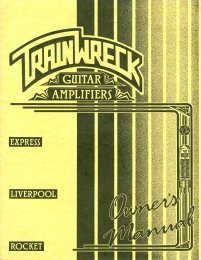
Ken Fischer's Trainwreck Circuits produced three basic models: The Express, The Liverpool, and The Rocket. He tended to vary the design for each amp depending on how it sounded. It's possible that no two Trainwreck amplifiers actually have the exact same circuit. Though all three basic models had three preamp tubes, usually 12AX7's, Ken would use different kinds of preamp tubes in his amp designs when he felt it would improve the amp he was working on. He sold Express amplifiers with two EL34's or two 6V6's for output tubes. Liverpool Amplifiers had four EL84 output tubes as did the Trainwreck Rocket. The Trainwreck Rocket also had a rectifier tube.
Webmaster's Note: The Trainwreck Rocket is the best sounding guitar amplifier I have ever heard.
Each Trainwreck amp came with a signed owner's manual containing the following graphic design and illustrations by Adam Apostolos. The text was written by Philip Lipman in conjunction with Ken and edited by Pam Sutherland.
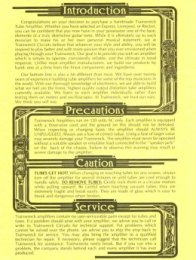
Congratulations on your decision to purchase a handmade Trainwreck Tube Amplifier. Whether you have selected an Express, Liverpool, or Rocket, you can be confident that you now have in your possession one of the basic elements of a truly distinctive guitar tone. While it is ultimately up to each musician to make his or her own personal musical statement, we at Trainwreck Circuits believe that whatever your style and ability, you will be inspired to play better and with more passion than you ever envisioned when playing through your Trainwreck. Our goal is to provide you with an amplifier which is simple to operate, consistently reliable, and the ultimate in tonal response. Unlike most amplifier manufacturers, we build our products by hand, one at a time from the finest components and ingredients.
Our bottom line is also a bit different than most. We have over twenty years of experience building tube amplifiers for some of the top musicians in the world. With our thorough knowledge of electronics, we are able to build II what we feel are the finest, highest quality output distortion tube amplifiers currently available. We listen to each amplifier individually rather than testing them on meters and oscilloscopes. At Trainwreck, we trust our ears. We think you will too.
Trainwreck Amplifiers run on 120 volts AC only. Each amplifier is equipped with a three-wire cord and the ground on this should not be defeated. When inspecting or changing fuses, the amplifier should ALWAYS BE UNPLUGGED. Always use a fuse of correct value. Using a fuse of larger value may severely damage your Trainwreck. The amplifier must never be operated without a suitable speaker or emulator load connected to the "speaker jack" on the back of the chassis. Failure to observe this warning may result in severe damage to the amplifier.
TUBES GET HOT! When changing or touching tubes for any reason, always turn off the amplifier for several minutes or until tubes are cool enough to handle safely. TO REMOVE TUBES: Gently rock them in a circular motion while pulling upward. Be careful when touching vacuum tubes: they are extremely fragile and break easily. They are made of glass which is easy to break and dangerous when broken.
Trainwreck amplifiers contain no user-serviceable parts except for tubes and fuses. If a problem should arise with your amplifier, we advise you to call or write to Trainwreck Circuits for technical support. For problems which cannot be solved over the phone, we advise you to ship the amp back to Trainwreck for service. You may also bring the amplifier to a qualified technician for repair. If necessary, please suggest that the technician call Trainwreck for assistance. Trainwrecks rarely break. But if you run into a problem, the company stands behind each and every amplifier it has ever produced.
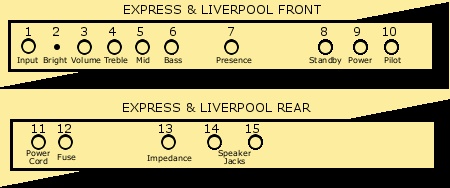
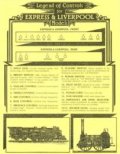
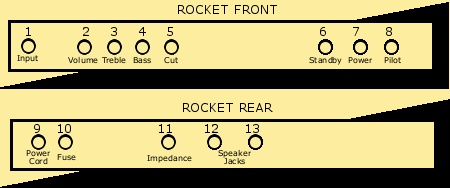
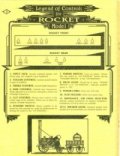
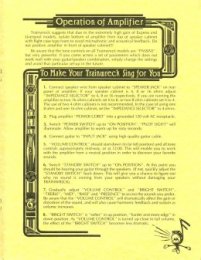
Trainwreck suggests that due to the extremely high gain of Express and Liverpool models, isolate bottom of amplifier from top of speaker cabinet with flight case type foam to avoid microphonic and acoustical feedback. Do not position amplifier in front of speaker cabinet!!!
Be aware that the tone controls on all Trainwreck models are "PASSIVE", but very powerful. If you come across a set of parameters which does not work well with your guitar/speaker combination, simply change the settings and avoid that particular set-up in the future.
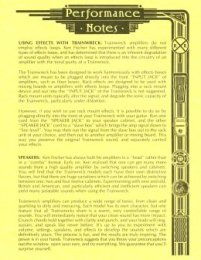
USING EFFECTS WITH TRAINWRECK: Trainwreck amplifiers do not employ effects loops. Ken Fischer has experimented with many different types of effects loops, and has determined that there is an inherent degradation of sound quality when an effects loop is introduced into the circuitry of an amplifier with the tonal purity of a Trainwreck.
The Trainwreck has been designed to work harmoniously with effects boxes which are meant to be plugged directly into the front "INPUT JACK" of amplifiers, such as floor boxes. Rack effects are designed to be used with mixing boards or amplifiers with effects loops. Plugging into a rack mount device and out into the "INPUT JACK" of the Trainwreck is not suggested. Rack mount units typically alter the signal, and degrade the sonic capacity of the Trainwreck, particularly under distortion.
However, if you wish to use rack mount effects, it is possible to do so by plugging directly into the front of your Trainwreck with your guitar. Run one cord from the "SPEAKER JACK" to your speaker cabinet, and the other "SPEAKER JACK" cord to a "slave box" which brings the amp signal down to "line level". You may then run the signal from the slave box out to the rack unit of your choice, and then out to another amplifier or mixing board. This way you preserve the original Trainwreck sound, and separately control your effects.
SPEAKERS: Ken Fischer has always built his amplifiers in a "head" rather than in a "combo" format. Early on, Ken realized that one can get many more sounds from a high quality amplifier by switching speakers and cabinets. You will find that the Trainwreck models each have their own distinctive flavors, but that there are huge variations which can be achieved by switching between one, two and four twelve cabinets. Experimenting with new and old, British and American, and particularly efficient and inefficient speakers can yield many palatable sounds when using the Trainwreck.
Trainwreck amplifiers can produce a wide range of tones, from clean and sparkling to dirty and menacing. Each model has its own character, but one feature that all Trainwrecks share is a warm, very controllable range of sounds. You will immediately notice that your clean sound has more impact. Crunch chords hold together with clarity and punch, and your leads will sing, sustain, and speak like never before. It's up to you to experiment with volume, settings, speakers, and effects to develop the sounds which are definitively yours. The process is fun, and the results are truly inspiring. The power is in your hands. Trainwreck suggests that you throw your preconceptions out the window, open your ears, and try everything. We guarantee that you'll surprise yourself.
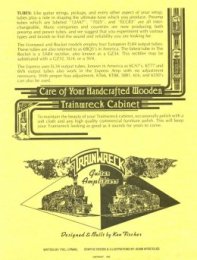
TUBES: Like guitar strings, pickups, and every other aspect of your setup, tubes playa role in shaping the ultimate tone which you produce. Preamp tubes which are labeled "12AX7", "7025", and "ECC83" are all interchangeable. Many companies and countries are now producing both preamp and power tubes, and we suggest that you experiment with various types and brands to find the sound and reliability you are looking for.
The Liverpool and Rocket models employ four European EL84 output tubes. These tubes are also referred to as 6BQ5's in America. The fattest tube in The Rocket is a 5AR4 rectifier, also known as a GZ34. This rectifier may be substituted with a GZ32, 5U4, or a 5V4.
The Express uses EL34 output tubes, known in America as 6CA7's. KT77 and 6V6 output tubes also work in the Express Amp with no adjustment necessary. With proper bias adjustment, KT66, KT88, 5881, 6L6, and 6550's can also be used.
To maintain the beauty of your Trainwreck cabinet, occasionally polish with a soft cloth and any high quality commercial furniture polish. This will keep your Trainwreck looking as good as it sounds for years to come.
